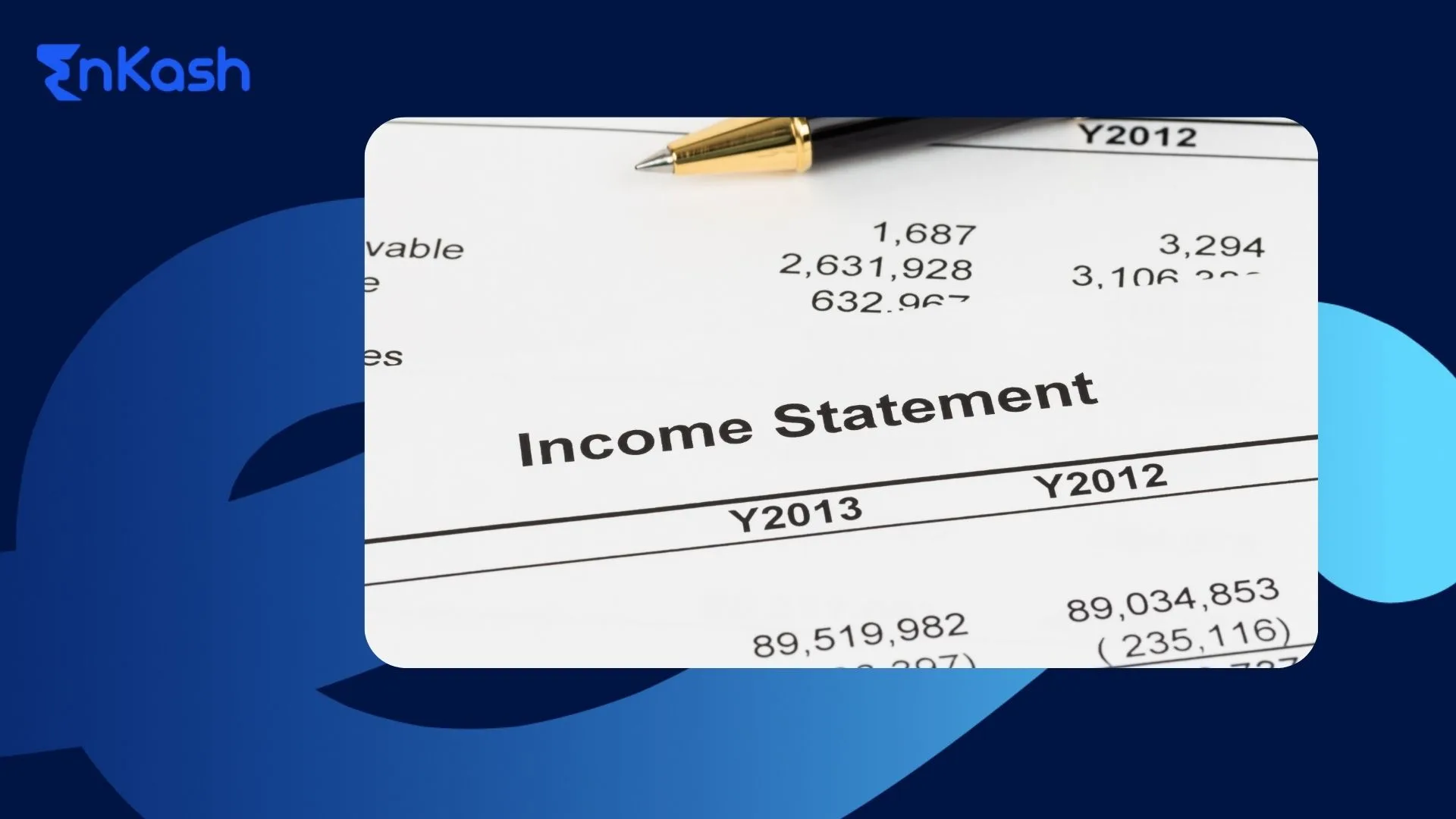Introduction
Starting a business is more than just marketing your product or service; you also need to plan budgets and track them to ensure long-term survival. Income statements are one of the basic financial reports every business should understand. An income statement is necessary to compile a financial performance report for a company. Such a report should be prepared periodically and is required to show the revenues of the company, expenses, and profits made over time, thus giving a view of the company’s financial performance. Thus, whether you are an entrepreneur, investor, or accountant, you all must understand income statements and their types, formats, and preparation, so you can make an informed decision for sustaining business growth.
What is an Income Statement?
What does an income statement exactly mean? The income statement is one very important report in accounting as it precisely summarizes the operations and activities of the company during that particular period. So, what does an income statement really mean? It is actually a financial statement wherein all revenue and costs or expenses incurred by a business during an accounting period, which could be a month, a quarter, or a year, are captured.
Net Income = Total Revenues – Total Expenses is the profit and loss formula that companies use to compute whether or not they have gained or lost anything during an interval. The income statement is one of the three core financial statements, along with the balance sheet and cash flow statement. Stakeholders are offered a full view of their status. It helps entrepreneurs to judge performance, banks, and investors to judge creditworthiness, with management making decisions based on it. In short, the income statement is very straightforward: it answers the most vital question of any business–is the company actually making money, or is it losing it? Without such a report, businesses would go around in circles trying to measure success, control expenses, and plan future growth.
Purpose of the Income Statement
An income statement is more than a financial report; it is the basis for evaluating how a business is performing in real time. Every company, big or small, resorts to this document to analyze revenue sources, control expenditures, and evaluate profitability. Here is why it matters:
Tracks Business Performance
An income statement shows how the company is recording its revenues and expenses. Revenues or sales are all the money collected by selling goods or services, whereas expenses are the costs for making those sales. Comparing these amounts for different accounting periods enables the company to measure its progress and ascertain trends.
Identifies Profit or Loss
Net Income = Total Revenues – Total Expenses
This formula helps determine whether the business makes a profit or incurs a loss. Where revenues are higher than expenses, profit is recorded; but if expenses are greater than revenues, a loss is reported, and practically, the business needs to take corrective action.
Supports Decision-Making
An income statement is crucial when it comes to making management decisions. Based on income, costs, and margins, management may decide to reduce expenses considered unnecessary, raise the price of a product, or work on operational efficiency. For instance, if sales are going up whilst net profit is stagnant, the income statement signals a need for scrutiny into overhead expenses.
Ensures Compliance
Every business is under some set of accounting records, auditing, taxation, and regulatory requirements. The income statements must form part of the corporate financial statements issued to authorities and interested parties. A properly prepared income statement will ensure conformity with accounting standards, thus reducing penalties or disputes.
Financial Guidance
Without income statements, businesses would be in the dark about their financial performance. This document thus becomes a compass to entrepreneurs, accountants, and investors in setting their short-term goals and budgeting for long-term viability.
Types of Income Statements
The income statement used by one firm may not be similar to that of another company. Depending on size, operations, and reporting requirements, companies can select between simple and detailed statements. Here are the main types:
Single-Step Income Statement
The simplest type of income statement is generally used by small companies and startups that have little or no selling and administrative expenses in their operations. It gathers total revenues and total expenses and simply subtracts expenses from revenues to arrive at a net profit or net loss.
Net Profit (Loss) = Revenues – Expenses
It is the easiest income statement to prepare and understand. However, bigger corporations might find the lack of detail a hindrance to analytical work.
Multi-Step Income Statement
The multi-step income statement is typically used by larger companies and those with complex operations. Unlike a single-step income statement that accumulates revenues and expenses, it holds revenues and expenses in separate content categories according to:
- Gross Profit (Revenue – Cost of Goods Sold)
- Operating Profit (Gross Profit – Operating Expenses)
- Net Profit (Operating Profit ± Other Income/Expenses)
This format gives nearly infinite insight into various layers of profitability. It brings out the effects of core aspects of business operations before externalities like interest or taxation can come into play.
Trading and Profit and Loss Accounts
It entails presenting trading results separately to yield gross profit from its core operation before any administrative or selling expenses are considered. In short, it pinpoints trading activities and how they impact profitability.
Income and Expenditure Account
The non-profit concern uses this account instead of an income statement. It records sources of income such as donations, grants, and subscriptions, and outflows such as salaries, program costs, and utilities. Though different in format, their aim remains the same: to determine whether the organization is living within its means.
Income Statement Format
The knowledge and understanding of the income statement format are very important; this statement has been structured to provide a presentation of financial performance. Normally, the statement starts with Revenue (What is Sales), i.e., gross earnings of a company by way of selling goods or rendering services. From this, the company deducts the Cost of Goods Sold (COGS), which consists of all direct costs.
For instance, raw materials and labor costs are used to calculate Gross Profit, which tells a lot about how well funds are utilized by a company to produce and sell products. Then, Operating Expenses, including salaries and wages, rents, utilities, and marketing, are deducted to reach Operating Profit, which is really the income derived from daily operations.
Another income-oriented line must include Other Income or Expenses, such as interest income, dividends, one-time gains or losses, etc. After that, the final income profit formula, Net Income = Total Revenues- Total Expenses, will be used to calculate the income or loss of the company.
Some companies also prepare a cost sheet under cost accounting practices to analyze direct and indirect production costs, though this is not a mandatory step after the income statement.
Key Elements of an Income Statement
Revenue / Sales
Revenue or sales means the total sum of money earned by the business in the course of selling goods and services during an accounting period. It is the top line of the income statement and upon which everything else is calculated.
Expenses
An expense is a cost that companies incur to earn revenue. These would include such things as salaries, rent, utilities, marketing, and administrative expenses. It is critical to keep an eye on expenses because excessive or uncontrolled expenses can almost instantly downsize the profitability of an organization.
Gross Profit
Gross profit is sales minus the Cost of Goods Sold (COGS). It shows how efficiently a company produces its products or provides its services. Generally, companies with higher gross profit margins convey good cost control and pricing strategies.
Operating Income
Operating income details earnings before interest and taxes (EBIT). The operating income checks only the operation of core businesses: income or expenses that are not operating. This is a way of checking how well the daily operations are performing.
Net Profit or Net Loss
This leads the business into net profit or net loss after deducting all expenses, taxes, and other items. The profit and loss account formula is applied here:
Net Income = Total Revenues – Total Expenses.
Profit implies revenues are more than expenses, while loss implies the revenues are less than expenses; therefore, the company must either work harder towards efficiency or look for ways to reduce costs.
Other Income or Expenses
These include non-operating activities such as interest income, dividends, sale of assets, or foreign exchange gains/losses. While these can add to profitability, they are not part of core business operations.
How to Prepare an Income Statement Step-by-Step
The process of preparing an income statement can seem intimidating; nevertheless, by following several clear steps, any business can obtain accurate and consistent statements. Here is a stepwise approach:
Step 1: Record Revenues
This is the first step in recording all revenues: it may be the sale of merchandise, goods, or services, or it may come from some other source. This constitutes the basis of the statement. Without accurate revenues, none of the rest of the document would be meaningfully constructed.
Step 2: Subtract Cost of Goods Sold (COGS)
From here, you subtract the cost of goods sold, which includes the direct cost of raw materials, labor, and expenses for running the factory. Most of the companies use a cost sheet format for the detailed computation of such costs. Revenue minus the COGS is gross profit.
Step 3: Deduct Operating Expenses
After gross profit, operating expenses are subtracted first. Among these are salaries, rent, depreciation, utilities, insurance costs, as well as maintenance and marketing costs. This leads to a very important step in the statement: it calculates operating profit, which tells how much income is being generated through core business operations.
Step 4: Add or Subtract Other Income/Expenses
In this stage, non-operating activities are considered. This could be income/interest from investments, foreign exchange loss, unusual expense, and so forth. This gives insight into the overall profitability.
Step 5: Calculate Net Profit or Loss
At the end of the day, one applies the income profit loss formula to determine the last figure: the net profit or loss. The said figure then serves as a judge of the company’s financial success or loss, pushing it further to corrective actions.
Importance of Accurate Preparation
An income statement is never prepared in isolation. The series of income statements, accompanying the balance sheet and cash flow statements, makes up the overall company financial statement package. It is critical to have it right because wrong entries would mislead stakeholders, affect investor confidence, and create issues in compliance.
Importance of Income Statements in Business Growth
Income statements are more than financial documents; they are decision-making tools providing distinct insights into a firm’s performance and growth aspects. Since an income statement shows revenues and expenses during a given period, businesses will be able to make decisions based on the financial viability of that operation. Below are the key factors that make income statements very relevant for business growth:
Decision Making
An income statement tells whether an enterprise is making a profit or a loss. Therefore, the management decides whether it is time to expand operations or invest in new projects, or if it needs a change in strategy to cut costs. So this financial information in front of the management forms a basis for making decisions that can be supported by facts.
Investor Trust
Prospective investors or banks weigh heavily on the income statement in assessing the credibility and stability of the company. The good and steady income trend will make an investor believe in the company; thus, it will be easier to source finance or obtain credit facilities for further expansion.
Performance Analysis
Such income statements keep track of the organization’s performance over time, in that comparisons are made relative to the performance of the previous months or current year. Trend analysis may thus focus on a particular area of strength or point out a problem, first on a very broad level, to consider guidelines for improvement.
Regulatory Compliance
Companies have the legal duty of complying with the preparation of financial statements for audit, tax filing, and accountancy standards of compliance. A correct income statement shall prevent a company from any penalties and help continue its transparency with the authorities.
A business that keeps a watch on income statements regularly is less likely to plunge into financial mismanagement. Moreover, by using digital platforms like EnKash, businesses find it easier to track expenses and financially report to make smarter and quicker decisions.
Conclusion
In conclusion, the income statement is not merely a financial report; rather, it forms the heart of sound business management. Owing to the clear presentation of revenues, expenses, profits, and losses, the income statement enables companies to comprehend the net actual meaning of their performances. It connects key concepts such as the income profit loss formula, sales, actual trade, profit and loss accounts, income and expenditure accounts, and cost sheet formats. Preparation of this statement for businesses, whether large or small, fosters transparency and trustworthiness with their stakeholders. Through EnKash and other such intelligent financial solutions, companies can focus on sustainable growth along with financial discipline while streamlining the entire process of reporting and verifying its accuracy.












